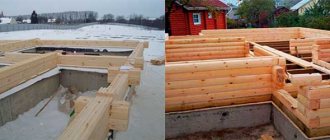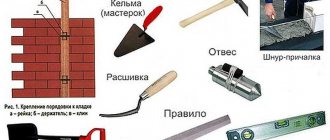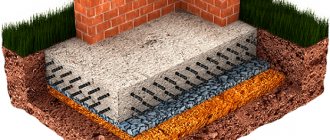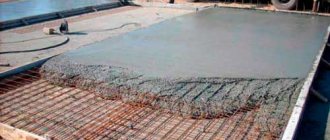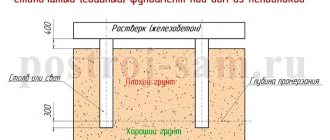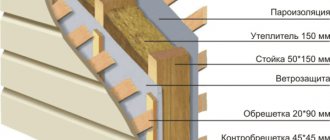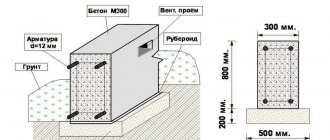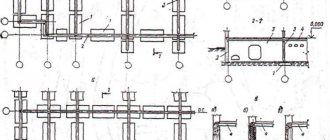Do-it-yourself foundation for the basement floor.
The basement floor is a room buried 2-2.2 m into the ground under the structure. Typically, this height is quite sufficient for constructing a warehouse, vegetable storehouse, workshop or other technical premises. If it is planned to install it in the basement of a living room, then the height is increased by 40-50 cm.
If the construction of a structure is carried out on unfavorable soils, then the thickness of the walls of the basement in a residential building cannot be less than 20 cm.
The underground room serves as an insulating layer for the above floors. It does not allow dampness from the soil and cold air to penetrate. To do this, when constructing an underground room, it is important to arrange an effective ventilation system.
How to build a foundation with a basement with your own hands?
The phased plan for the construction of a foundation with a residential base consists of the following points:
- Cleaning and marking the construction site.
- Arrangement of pits and trenches for utilities.
- Arrangement of drainage bedding under the base of the future foundation.
- Arrangement of waterproofing of the foundation base.
- Construction of the base sole.
- Construction of foundation walls.
- Waterproofing and thermal insulation of base walls.
- Backfilling of soil with the obligatory arrangement of a drainage layer under the foundation wall.
- Arrangement of the blind area and front finishing of the basement part of the building.
The first four stages are carried out using generally accepted technologies practiced in the construction of a conventional strip or slab foundation. That is, before making a foundation for a house with a basement, the area is cleared of fertile soil (it will be useful in flower beds), the upper boundary of the pit is marked and excavation work begins.
Digging a pit is carried out in stages, by selecting 50-centimeter layers of soil. As a result, the walls of the pit have a stepped structure, and only the bottom of the excavation coincides with the dimensions of the future foundation.
The backfill of the drainage layer is arranged by placing a 15 or 20-centimeter layer of sand and fine gravel at the bottom of the pit. Rolled waterproofing (membrane film or roofing felt) is laid on top of this sandwich.
But the work on the construction of the base and foundation walls is carried out using individual technology, characteristic only for the construction of monolithic foundations with a basement. Therefore, we will take a special look at the construction of the base and walls.
Filling the base
The construction of the base base involves pouring a classic foundation slab, along the perimeter of which reinforcement outlets are left. That is, removable formwork is laid around the perimeter of the last step of the pit, inside which a reinforcement frame with vertical posts rising above the edge of the deck is installed.
However, when independently arranging a deep basement, a labor-intensive continuous foundation base is not built. Instead of a monolithic slab, you can get by with a wide strip, the dimensions of which exceed the thickness of the foundation walls by 40-50 centimeters (20-25 centimeters on each edge). Such a sole will work no worse than a monolith, increasing the bearing capacity of the soil.
Well, the floor of the future basement can be poured on top of a crushed stone bedding laid directly on the waterproofing layer.
As a result, the least labor-intensive process of filling the sole looks like this:
- Along the contour of the walls, a classic, double-walled formwork is built, arranged with an overlap of 20-25 centimeters on each side of the wall.
- The decks are reinforced with transverse struts and side scaffolding.
- Meshes of 12-mm reinforcement are placed in the inner part of the formwork, which are connected to vertical, remote pins.
- The formwork body is filled with concrete grade M300 or M400.
After the concrete has hardened, the formwork is dismantled, and the side edges of the sole are coated with moisture-repellent mastic.
How to pour a foundation with a basement - stages of work
Having completed the construction of the base, you can begin to build the foundation walls. Moreover, the fastest and most reliable way to build such walls is to pour foam or hollow formwork blocks into permanent formwork.
Using formwork blocks you can save time on the construction of labor-intensive panel formwork, the deck height of which will be 2-2.5 meters. However, panel formwork is cheaper than the block version.
The construction of block formwork is reminiscent of assembling a wall from children's construction sets.
In practice, this process looks like this:
- The blocks are placed in special grooves, which eliminates the possibility of the wall of the future foundation being skewed. In addition, block formwork does not require supporting scaffolding.
- The reinforcing frame is laid between the blocks, on transverse ties laid inside the formwork.
- Vertical reinforcement pins are connected to the outlets of the sole and are located in the internal cavities of the blocks.
Concrete is poured in layers, the depth of which should not exceed 30 centimeters. The foundation grillage is the top edge of the monolithic fill.
The construction of panel formwork involves the assembly of a double-walled structure from metal or wooden decks, the height of which is equal to the height of the foundation wall. This type of structure requires complex support scaffolding to hold the decks in place while the foundation wall is poured. Filling is carried out according to the same layer-by-layer principle.
Types of foundations for the basement.
- Recessed plinth. This is the most common type of foundation, as it best helps protect the base and walls of the building from moisture penetration, significantly increasing the service life of the entire structure.
- Protruding base. This type of foundation is most suitable for buildings with thin walls. When constructing a basement floor as a living space, a protruding plinth will be quite justified. If you plan to use the basement as a technical room, then its walls can be made thinner;
- The basement level with the foundation is not the best option. First of all, this is the lack of effective protection from moisture and precipitation. In addition, such a base requires additional waterproofing, and therefore costs, and from the outside it does not look very aesthetically pleasing.
Strip foundation for the basement floor.
Many developers strive to increase the ceiling height of the basement floor, making it a full-fledged room. To do this, you need to dig a pit of the required depth. The thickness of the basement walls can be equal to the thickness of the building walls. When construction is carried out on “weak” soils, the thickness of the walls should be 20 cm greater than that of the walls of the house.
Solid concrete blocks may be quite suitable for wooden cottages.
During seasonal floods, close groundwater, including high levels of ground freezing, it is important to know how to protect the foundation.
Construction of a basement under the house
- If the depth of the foundation of the house is sufficient for constructing a basement, then a pit must be dug inside the old foundation, not forgetting that it is necessary to retreat from the existing foundation by at least 1 - 1.2 m. And if the house is two-story, then 2 m. This is It is necessary to ensure that the soil crumbling from the walls of the pit does not affect the stability of the foundation.
- The bottom of the resulting pit must be thoroughly compacted. Then polyethylene is laid on it and a cushion of crushed stone and sand is placed over it.
- Another layer of polyethylene is laid on top of the pillow, overlapping the walls of the pit, which will serve as waterproofing for the basement.
- A reinforced concrete slab is installed on top of the waterproofing layer, which will be the basement floor.
- After the floor has hardened, it is necessary to set up the formwork and fill the basement walls, also using reinforcement. If the soil is dense, then the walls of the basement can be laid with bricks and plastered.
- It is necessary to provide ventilation for the basement, otherwise it will be damp.
- All that remains is to restore the floors of the room and make a hatch into the basement.
If the basement area is large, then the descent to the basement can be organized as a regular flight of stairs. If there is not enough space, then you will have to use an extension ladder. The main advantage of this method of building a basement is the ability to do all the work yourself.
Among the disadvantages are the following:
- The need to carry out all work manually due to the impossibility of using technology.
- Soil is removed through living quarters, which is not very convenient for both workers and household members.
- Not everyone can properly install ventilation and waterproofing of the foundation, which in the future can make it difficult to use the basement for its intended purpose, as well as lead to the appearance of dampness in it.
If it is possible to make a basement during the construction of a house, you should prefer this option. The room will be much larger in area and better equipped.
(Visited 478 times, 1 visits today)
Construction of a slab foundation.
The most advantageous type of foundation that can support a building of any weight. This type of foundation is called floating - in the process of seasonal soil movements, the concrete foundation lowers or rises along with the structure.
When constructing such a foundation, the pit is made half a meter below the planned depth, and the selected soil is replaced with sand, which must be thoroughly watered and compacted. After this, crushed stone is poured. The thickness of the layer of sand and crushed stone should be at least 15-20 cm.
Turnkey basement foundation calculator.
The “cushion” arranged in this way is filled with concrete 4-5 cm thick. Then waterproofing is laid. As a rule, roofing felt or waterproofing film is used, after which everything is again filled with concrete to the same thickness.
Then the reinforcement is laid, a thermal insulation layer is laid, and concrete is poured again. This time the layer thickness should be at least 20 cm.
Construction of a monolithic strip foundation.
After the pit is ready, markings are made at the bottom of the dug hole according to the diagram of the load-bearing walls of the building. Next, according to the markings, trenches with a depth of at least 30 cm are dug. Then a drainage system is installed - the trenches are strengthened with formwork and covered with crushed stone on top.
Then reinforcement is made and the concrete mixture is poured. The width of the pillow should be greater than that of the basement walls and, as a rule, it is 30-40 cm high and 50-60 cm wide.
Foundation for the ground floor.
Basement waterproofing
The structure with a basement floor must be treated with waterproofing materials. You can do this yourself. For such purposes, concrete is used, which absorbs moisture well. Waterproofing should be installed on the outside and inside of the building.
From all of the above, we can conclude that building a foundation for a basement floor is a rather labor-intensive job that requires certain construction skills. Despite the fact that the article describes in some detail all stages of construction, it may not help the owner of a private building when constructing a foundation. In this case, it is best to contact specialists during the arrangement to develop a thorough design of the basement floor and carry out all subsequent work.
Block strip foundation.
This type of foundation is made from piece products - factory-produced reinforced concrete blocks. Its advantages are speed and ease of assembly.
However, it is recommended to use this type of foundation for the foundation only on dense soils, where groundwater lies quite deep.
Turnkey foundation with basement price.
Waterproofing.
Even if the soil is not oversaturated with water, it is impossible to do without waterproofing. Its absence can ruin the entire building, even if the basement floor is planned to be used exclusively as a technical room.
There are two ways:
- coating waterproofing is produced using bitumen mixtures, which are applied to the surface in a heated state;
- adhesive waterproofing is made from materials intended for roof waterproofing using the appropriate application technology.
Waterproofing must be done in two layers. It is mandatory to cover with waterproofing all vertical and horizontal sections of the foundation and walls that come into contact with the earth's surface.
Before erecting the walls of the basement, you will need to insulate them from the cushion to prevent moisture from entering, and subsequently connect the vertical insulation of the walls as tightly as possible with the insulation of the floor and cushion.
After erecting the walls of the ground floor, a sufficiently wide blind area should be built from the outer part of the building, using a concrete mixture for this.
Modern craftsmen are quite capable of laying a foundation for the basement floor with their own hands. Of course, in such a rather labor-intensive task, assistants and construction equipment will be required. But for a person with minimal experience in construction, this is possible.
Foundation for a house with a basement.
Building a house with a ground or basement floor is always more expensive than building a completely above-ground structure. However, in the future all expenses are fully justified. The underground room for the upper floors will be an excellent insulating layer through which cold air and dampness from the ground will not penetrate. In addition, a foundation with a basement can significantly increase the usable area of the house.
Experts consider the basement or basement floor to be a room that is buried 200-220 cm into the ground under the house. As a rule, this height is enough to make a warehouse, cellar, workshop and any other technical room with your own hands. If a living room is required, then it is advisable to increase the height by 40-50 cm. Specifically, the “basement” floor means a room that is buried in the ground no more than half its height.
When constructing an underground room, it is necessary to provide an effective ventilation system that will ensure air circulation and allow the removal of radon (a gas that can accumulate in pits and underground rooms).
Turnkey basement foundation.
Construction of a cellar in a house with a strip foundation
The simplest room under the floor is called a cellar and has a number of significant differences from the basement:
- The cellar performs only storage functions: a consistently positive low temperature is almost always maintained under the floor. This is the optimal mode for storing food.
- The cellar does not necessarily occupy the entire space limited by the foundation walls.
- The depth of the cellar may not be enough for free movement, but the volume of the underground space should be sufficient for storage.
- Setting up a cellar does not involve large expenses for installing floors, finishing walls, or installing stairs.
- Cellar ventilation is usually ensured only by opening the entrance hatch (manhole).
- Apart from minimal lighting, no engineering systems are used in the cellar.
This is interesting: what are the differences between a cellar and a basement?
Cellars can be installed in existing buildings that have been in use for a long time, rather than being designed before construction begins. Such premises are usually located in small country houses, garages and outbuildings.
In this video we will look at a basement with a strip foundation:
Which foundation design to choose?
If you decide to make a basement, and its floor will be located below ground level, then you need to take into account the groundwater level in the area. When the GWL is low, you can go several meters into the ground without much expense. In such cases, you can use a strip block or monolithic foundation.
As practice shows, when the groundwater level is high, it is best to prefer a monolithic foundation, which will allow the foundation to successfully resist the effects of moisture, as well as prevent flooding of the ground floor and basement. At the same time, you will need to organize high-quality waterproofing yourself. The construction of a house in the case of a monolithic foundation is simplified due to the fact that the foundation can support maximum loads. When choosing a slab foundation for a basement floor made of a reinforced concrete slab, you will need to either fill the pit with cement mortar yourself, or order the laying of factory-made slabs.
Also, at high groundwater levels, the pile type of foundation has proven itself well.
If you have chosen a strip foundation with a plinth, but there is a high groundwater level on the site, then the problem can be partially solved by installing a reliable drainage system. The installation of a drainage system will effectively remove moisture from the foundation and the house, so it will not negatively affect the building structure.
Arranging a foundation with a basement: stages of work
When starting construction, it is necessary to carefully calculate the height of the future room to minimize errors and subsequent alterations.
When starting construction, it is necessary to carefully calculate the height of the future room to minimize errors and subsequent alterations. It is very good if you can stand at full height in the basement, but it all depends on the capabilities of the user.
The height of the base must correspond to the height of the basement, taking into account the level of ground aquifers and the freezing point of the soil. The operating procedure is as follows:
Layout of the foundation of the house, in which the stress of the foundation is calculated and a method for eliminating the fact is determined. Drawing up a list of materials and tools (it is better to take them with a reserve). The marking of the base of the house is carried out taking into account the characteristics of the construction site.
It is important to choose the most optimal location for the future structure. Experts offer the following marking instructions:
- drive pegs into the ground to mark the corners of the building;
- pull the threads diagonally, and be sure to measure the length of the threads - it should be identical;
- If there is the slightest error in the length or shift of the peg, repeat the process.
Now you can start arranging the foundation, consider the strip type of foundation, the construction of which is clearly shown in the video, and carrying out the processes of arranging the foundation with your own hands is not very difficult.
- Dig a trench around the perimeter of the building, removing excess soil.
- Place a cushion of gravel-sand mixture up to 30 cm high at the bottom of the trench and level it.
- Line the pillow with roofing felt.
- Make formwork from the boards.
- Build a reinforcing frame from rods, install the mesh at a height of 5 cm below the level of the base.
- Wet the formwork with water. Prepare concrete mixture for pouring.
- Pour the strip foundation layer by layer, compacting each layer and releasing air.
- Allow the mixture to harden for 21 days.
- Remove the formwork and fill the voids with soil.
Now that the foundation for your building is ready, you can begin arranging the basement. What to do:
- Dig a pit for arranging a basement. The soil needs to be removed;
- Cover the bottom of the pit with crushed stone or gravel chips of the middle fraction. Backfill thickness is maximum 15 cm. Tamp down;
- Prepare cement mortar and pour the floor;
- Construct wall planes and waterproof the basement walls with any available material;
- Also waterproof the foundation where the basement is being built. The procedure will reduce the influence of external factors on the entire structure.
As you can see, you can build a house with a cellar by creating a strip foundation with your own hands. The technology is available and in demand, especially in areas where the geological characteristics of the soil make it possible to create a foundation with an increased depth of the base. The main processes are clearly shown in the video, so if you have any questions, the master class will provide detailed explanations for each of them.
And remember that it is better to carry out all processes in the warm season: the installation of the base requires good drying of the concrete composition from which the foundation strip is made and the cement mortar used to construct the floor slab in the basement.
Monolithic.
This type of foundation cannot be called the cheapest, but it is the most effective from many points of view. First of all, a monolithic foundation can withstand severe loads (you can even build a three-story cottage). To construct such a foundation, a deep pit is dug, after which the depth is increased by approximately 50 cm from the expected level of laying the slab in order to make a sand and gravel cushion on which the monolithic base will be located.
Foundation for the ground floor price.
After compacting this pillow, it is poured with a concrete layer several centimeters thick. Then a waterproofing material is laid, on which a layer of concrete is again poured. After this, a reinforcing mesh is installed, which will ensure a high level of reliability of the foundation for the basement floor. Concrete mortar is again poured onto the reinforcement in a layer 20-30 cm thick.
Such a foundation is usually called “floating”. If there is ground movement, the foundation will rise and fall along with the entire building. Today, a floating base is made in many cases when it is necessary to organize a basement in a house with your own hands.
The installation of a strip foundation is also a fairly common practice. Such a foundation is needed in cases where a small house is being built in an area with low groundwater levels. You can make the base yourself. This type of foundation is quite affordable in price and is the most economical option, but not the most reliable.
Foundation for a house with a basement.
Pouring the strip base.
The ground floor will be located directly under the premises of the country house, sharing the same walls with them. This is very convenient because the basement will be divided into separate sections that can be used for different purposes.
There are two types of strip foundations that are used today:
- Blocky. A strip foundation with a plinth is erected from reinforced concrete blocks. The main advantages of such a base are speed and ease of installation. This foundation for country houses can only be built on dense soil with low groundwater level.
- Monolithic. It has an almost similar device. The difference is that before building the foundation, it is necessary to pour a “cushion”, as is the case with a slab foundation. After that, formwork is made, on which a reinforcing mesh is laid and filled with concrete. If it is necessary to build a foundation for a basement floor, then a monolithic strip foundation is often used.
In recent years, more and more homeowners are building their homes on pile foundations. And this is no coincidence, because it is precisely this foundation that looks like the most reliable and independent solution. Installation of piles can be done at any time of the year and with any groundwater level. Screw piles securely hold the building and are not affected by groundwater. In addition, you can make the basement floor yourself - however you like and at your personal discretion. The construction of houses with pile foundations is usually carried out by professionals, because installing piles requires special equipment and skills. Using a pile foundation for the basement floor is a completely rational solution.
Foundation for the ground floor.
The option is not bad, but quite expensive when compared with a traditional strip foundation. Screw piles must be selected individually depending on the terrain and soil type. In addition, during construction it is necessary to provide for many different aspects that non-professionals know nothing about. For example, screw piles can be used for houses of the same type in different quantities.
In a house on a pile foundation, the basement must be finished with high quality, because the internal structures of the building (basement walls, ceilings, etc.) remain unprotected. Various facing materials can be used for finishing. It is also recommended to install additional external layers of waterproofing and thermal insulation. In a house on a pile foundation, the easiest way is to create a residential basement.
Piles used as a foundation can last as long as a monolithic foundation. On the other hand, in no case should the piles be further tightened after the construction of the building in order to level its level. If the piles are twisted during operation, this can lead to negative consequences. Piles for all buildings are selected individually.
Foundation of a house with a basement level.
Diagram of a metal screw pile.
General information
The base is the continuation of the foundation above the zero point of the construction site. Usually it rises 500-700 mm above the base, making a kind of transition to the wall. Its main purpose is to protect the house from moisture penetration from the foundation.
Construction of a basement floor from cinder block
Basement floor - a room from above the zero point of the construction site to the level of the first floor. If it is located lower, then it is called a basement. The basement floor of the foundation is used in a very varied way, for example, a gym, a bathhouse, a home theater or a children's playroom are placed here. .
Types of base
Experts identify three options:
- flush with the foundation;
- protruding;
- recessed
The last option is considered the most common, and not because it looks more attractive in terms of construction. It is in this case that the least amount of moisture gets on it, since it quickly drains from it, thereby protecting it, the walls and the foundation of the building from destruction. The undoubted advantage of this type of base is its economic feasibility, since its price is much lower than other designs.
Inside the basement
What you should know
- For thin walls of a house, it is better to use a protruding version of the base . It is also most justified when planning the arrangement of the premises on the ground floor, because they will be warm, since they will be located almost underground.
- If the room is intended to be used as a storage room for unnecessary things, it is more advisable to make it thin.
- It is not recommended to build the base flush with the base, since it will practically be the beginning of the walls, and therefore will not provide the necessary protection from moisture . The foundation plinth structures will need to be pre-coated with waterproofing, which is not economical from a financial point of view, and also will not add beauty to the structure.
Strip foundation for the basement floor
Construction
Remember, if the house has an underground floor, the foundation base should be covered from the outside with waterproofing material and insulated from the inside. The instructions say that the minimum height of the plinth is 500 mm, the minimum height of the basement is 1500-2000 mm.
Don't forget to leave ventilation holes for the basement space. Usually they are done at the same level at a height of 150 mm from the ground.
Foundation for a house with a cinder block basement
Tip: to protect the ventilation holes from debris, cover them with a mesh or, in cold weather, with a thick cloth.
Foundation with basement
Most often, the foundation for the basement floor is made monolithic, strip-type or prefabricated. When calculating its parameters, it is necessary to determine the depth of the foundation. For example, if it turns out that the freezing point of the soil is located below the zero level at a depth of 1.6 m, then the foundation should begin to be built from 1.8 m.
Advice: start building the basement only 10-14 days after pouring the foundation, when it reaches approximately 80% strength.
Prefabricated foundation for a house with a basement
Process
Before making the foundation of the basement floor with your own hands, it is necessary to analyze the soil on the site and determine at what depths the groundwater lies. If closer than one and a half meters to the surface of the site, the recess under the room should not exceed one meter. The area should be leveled, and if necessary, add an additional layer of soil.
If the location is very close to the groundwater surface, the area should be drained before foundation work. To do this, drainage lines are laid, which make it possible to divert water from the object and allow the construction of a deeper foundation.
The structure of the base can be:
- Prefabricated, when it is laid out from any piece of material, for example, from red brick or even from reinforced concrete slabs. Very often, the basement is made from foundation blocks 400-600 mm wide with a pitch of 100 mm. Their length is 900-1200 mm in increments of 100 mm. When the soil is weak, a layer of sand (150 mm) must first be laid under them, and then a reinforced concrete pad.
Ground floor for a residential building
- Monolithic, which is much more difficult to make, therefore there will be more technical errors in this case. After the foundation has gained sufficient strength, formwork is installed for the basement floor. You can purchase it ready-made or make it yourself from boards with a smooth surface on the concrete side. Shields should be made from them and secured to each other in different ways. After this, a frame of reinforcement is installed in the formwork to give strength to the product. Rods Ø 12 mm are used, which are connected by welding or knitting wire to a cell of 150-250 mm. In this case, the reinforcement should not reach 50-100 mm to the edge of the base. Then a fresh concrete solution is poured into the formwork.
Manufacturing using formwork
When, according to the plan, the base is high enough, several such frames may be needed. Therefore, they should be placed at different levels with a distance of 300-500 mm from each other. Attach the structures to each other with vertical jumpers, also made from reinforcing bars.
Another option for laying the reinforcing mesh: pour a layer of mortar (150 mm), when it hardens slightly, lay the reinforcement, again pour a 300-400 mm layer of concrete on top and lay the mesh again. The process can be continued to the desired level. After 10-12 days the solution will become strong, then remove the formwork.
You can make a plinth using natural stones, but this will require certain knowledge. In most cases, because the material does not have the same size and shape.
Home gym in the basement
The most common base is made of red brick. Moreover, they use both a special decorative material and prepare it for further plastering or cladding. You can look at other interesting projects of foundations with a basement on our website.
Blind area device.
To protect the foundation of the house from moisture, it is necessary to arrange a blind area around the perimeter of the building. This can be done with your own hands. If the blind area is made with high quality, you will not have to worry about precipitation penetrating into the structure of the house. In addition, it is the blind area that often becomes one of the main decorative elements of country houses.
The upper part of the blind area can be made of different materials: gravel, crushed stone, brick, natural stone, slabs, concrete, asphalt, etc. The main material should be selected depending on the upper part, but in any case it is necessary to ensure the highest level of waterproofing. Very often a thermal insulation layer is also needed. With a high-quality blind area, the foundation base will experience minimal impact.
The width of the blind area being installed will depend on the protrusion of the roof eaves and the type of soil in the area. As a rule, the blind area is approximately 20-25 cm wider than the cornice. You can do the construction of the blind area yourself or hire specialists who will take into account all the nuances.
If the area is dry and non-subsidence soil, and the house is built on a columnar foundation, then there is little point in constructing a blind area. But in those places where water flows from the roof, it is necessary in any case to make a small protection against soil erosion.
In some cases, the blind area is the only protection against moisture penetration into the interior of the building. If the blind area is done correctly, then it will be able to cope with this task.
Building a foundation with a basement with your own hands is possible in any conditions. However, it is necessary to take into account many nuances: type of soil, groundwater level, climate, height of the house, materials used for construction, etc. It is worth noting that the construction of a country house must be agreed upon with the relevant authorities, who can also advise one or another type of foundation for the construction of a structure.
Cellar: structural solutions
Any cellar is an isolated underground chamber, or a partially buried room, which has its own foundation; walls; ceiling and entrance doors with stairs. In different cases, different materials are used to build a cellar: remains from the construction of the main building, natural materials (stone, wood). The foundation for the construction of a cellar can be made of two types:
- Strip foundation - this option is used for dense foundation soils with a low groundwater level.
- Recessed monolithic slab - this type of foundation is used in wet soils, as well as in the case of attaching a cellar to an existing building with an erected strip foundation (cellar in a house).
Construction of a strip foundation for a cellar
How to properly make a strip foundation for building a cellar? A detailed description of the construction work will allow even a non-specialist to build a strong foundation for a cellar.
Preparatory work
Digging a foundation pit
First, you need to decide on the size of the cellar, after which you need to clear the construction site, removing debris, vegetation, and all existing obstacles. The site is leveled, carrying out the necessary planning work. If the cellar is not planned to be deepened, trenches are dug along the perimeter of the planned structure. The trench depth is provided up to 44 cm, width – up to 30 cm.
When the cellar is partially buried in the ground, trenches are dug to a greater depth, and shields are immediately installed to protect the walls from collapse.
The bottom of the trenches is leveled, compacted and covered with a layer of coarse sand (up to 10 cm), which is compacted and spilled with water.
The compacted sand must be backfilled with crushed stone with a fraction of up to 20 mm, which is leveled and compacted. The thickness of the crushed stone layer for backfilling is 10 cm.
Formwork and reinforcement cage
Installation of strip base formwork
To maintain the rigidity of the foundation and give it strength, a special spatial frame is made from reinforcement with a diameter of 10 mm, which can be connected with knitting wire or welding. Frames made using welding are less durable than those connected with wire.
A reinforced frame for strip foundation structures prevents deformation of the foundation base when exposed to uneven loads.
The location of the reinforcement cage in the body of the foundation should be monitored; displacement of the spatial structure relative to the center of the foundation horizontally and vertically is not allowed. Before pouring the concrete solution, the reinforcement frame should be leveled, if necessary, raising it on bricks above the crushed stone cushion.
Formwork panels are made from wooden boards and durable plywood. It is allowed to use ready-made panels of reusable dismountable formwork, which must first be cleaned of layers of dirt and concrete mortar. The formwork is placed along the walls of the dug trenches, strengthened by placing struts and supports
It is very important to maintain verticality when placing formwork panels. When using uneven boards to make formwork, the gaps between them should be insulated with roofing felt.
Concreting
Pouring concrete solution
Concrete pouring must be done at one time to prevent the appearance of “cold bridges” due to uneven hardening of the concrete mixture. You should start pouring the strip foundation with concrete from the corner of the structure (it is possible to fill the formwork with the mixture simultaneously from two corners diagonally).
After pouring the mixture into the formwork, tamping should be done using a vibrator - this will fill the resulting internal voids with concrete, which subsequently greatly weaken the strength of the foundation base.
The surface of the concrete in a strip foundation must be looked after - the upper part of the foundation is moistened several times a day, and also covered with a film to prevent premature drying.
The foundation structure for a cellar gains strength in 28 days. What can be done during this period at the construction site? It is allowed to remove the formwork panels approximately 2 weeks after pouring the concrete mixture.
The foundation for a utility cellar can be strip support structures made of precast reinforced concrete, the installation of which will require special lifting equipment. The joints between the elements are carefully sealed with concrete mortar.
Foundation for a house with a basement (advice from experts).
When starting to build a house, you should decide what the ground floor will be used for.
If there is a living space, games room or gym located there, the ceiling must be at a height of at least 220 cm.
If this space is intended to be used as a utility room, the ceiling may be lower.
You can build the foundation for a house with a basement floor on your own.
To do this, it is necessary to consider the features of such structures and understand the rules for carrying out installation work.
Types of base and construction features
In relation to the main wall, the plinth can be of the following types:
- Speaker . In this case, the walls of the basement are several times thicker than the main walls of the house. This design is practical, economical and can be erected in a short time.
- Located in line with load-bearing walls . This design involves the construction of a basement and main walls of approximately the same thickness. In this situation, special attention should be paid to waterproofing the basement floor in order to protect its surface from the negative effects of various natural phenomena and extend its service life.
- Sunken . The design is distinguished by its non-standard appearance, attractive from an architectural point of view. Such a base is reliable and practical, in addition, less moisture gets on it, which drains off quickly enough. As a result, the base itself and the foundation of the building are protected from the destructive effects of water.
When choosing the type of base, you should adhere to several rules:
- For thin-walled buildings it is better to build a protruding base. It is recommended to use this same option if the ground floor will be equipped as a residential premises. Despite the partial placement underground, this part of the house will also be warm.
- If the room is used as a storage room, then the sinking plinth will be beneficial from the economic side.
- If possible, avoid building the plinth flush with the base. In this case, the outer surface of the base and the main wall will be located in the same plane, which reduces the degree of protection from the destructive effects of moisture. In addition, insulation and waterproofing require additional costs, and the appearance loses its attractiveness.
Expert advice.
When constructing a foundation for a building that includes a basement, the following points should be taken into account:
- If the space of the room will be used for technical purposes, you can use walls with a small thickness and a protruding design option. As a result, construction will require less money and time.
- It is impossible for the base to be at the same level as the foundation. In this case, it will be a continuation of the wall covering and will not be able to protect against moisture.
- If the room will house a playroom or bathhouse, it is better to use a recessed type of foundation. It is easily insulated. Waterproofing work does not require large investments.
- At the design stage, you should consider how the ventilation system will work.
- When choosing the height of the room, you need to pay attention to the characteristics of the soil. The floor of the rooms should be located lower than the freezing level of the soil.
- Before starting work, geological studies of the soil should be carried out. To do this, it is better to seek help from specialists.
Construction of a basement in a house with a pile foundation
Modern technologies help connect the pile foundation to the basement. This solution is becoming increasingly popular
It is important to determine the dimensions and structure of the basement and make accurate calculations at the design stage
Design features of screw piles
Screw piles are tubular metal structures with a pointed end. A blade is attached to the sharp tip. It helps to screw the pile into the ground. The foundation for the future building is attached to the head.
The construction of a pile foundation is justified on heavily watered, clayey or soft soils, and quicksand. Screwing in the pipe rod does not loosen the soil. On the contrary, the soil is compacted around the pile. Each support can withstand loads of up to 7 tons.
Screw piles are installed at a distance of up to 2 m. To give greater strength, the upper platforms of the piles are connected with a grillage. This base can be reinforced and filled with concrete. The structure becomes connected.
The number of screw rods is determined by calculations based on permissible loads on the grillage. For example, for a house measuring 6x6 m, 12 - 16 piles will be required. Installation of the structure is quick. The specified number of screw piles is installed in approximately 3 days.
Main requirements
Not every construction company will undertake the equipment of a basement with a pile foundation. And independent construction is fraught with unforeseen consequences
Success is guaranteed by extreme caution and accurate calculations
At the design stage, the distance from the piles to the cellar walls is taken into account. The distance should not be less than 2 m. Violation of this requirement leads to loss of stability of the rods and to subsidence of the soil.
To dig a pit for a cellar, you need to know the location of each pile. The walls of the cellar are erected inside a perimeter outlined by screw piles. Maintain the same distance from the supports.
Pile pillars are selected according to:
- type of structure;
- area of the area;
- type of soil.
The materials for the walls are tarred logs, bricks, and reinforced concrete blocks. Additional layers of thermal insulation and waterproofing are used. To protect walls and façade finishing, cladding materials are used.
Sequence of work
The basement is equipped simultaneously with the construction of the foundation or after its laying. The usual sequence of work looks like this.
- They dig a pit. Its dimensions should be larger than the planned perimeter of the basement.
- Pour a cushion of crushed stone and sand and compact it thoroughly.
- Waterproofing is laid on top. It is made from roofing felt or thick film.
- A fine mesh is laid on the waterproofing layer. Concrete is poured and screed is performed.
- They begin to build the walls.
- The gaps between the walls of the pit and the basement are filled with sand. For better compaction, the sand is watered.
Neglect of the main requirements and a certain sequence of work may lead to a weakening of the pile foundation. Inadequacies and negligence during work can contribute to the destructive effects of soil swelling. In such cases, the results may become unpredictable.
Recommendations and tips
Often a separate strip base is prepared for the cellar. It is recommended to make the basement foundation light and connect it with screw rods. For greater reliability, the structure is reinforced with a grillage. The result is a kind of hybrid - a pile-tape base.
The grillage is raised to the height of the planned basement. It is necessary to take care of the construction of a capital drainage system.
Equipping a basement with a pile foundation requires covering the base. Solving this problem improves the design appearance of the building and increases its energy efficiency. Cover the base:
- miniature strip base;
- insulation over the beams, which are attached to the grillage and piles.
In option 1, a trench is dug around the perimeter of the foundation. The recess is reinforced and filled with concrete. A brick is placed on top of the frozen base and covered with insulation. The mini-foundation is covered with decorative panels.
In the 2nd option, beams are attached to the grillage and piles. Insulation is placed between them. Penoplex or polystyrene foam will do. At the final stage, decorative siding is installed.
It is better to give oval shapes to the walls of the basement. Then it is possible to avoid destructive point loads that occur when the soil swells. The oval shape softens the pressure on the walls and evenly distributes the load along the vertical area.
The strip-pile foundation is successfully combined with the basement and receives improved energy efficiency.
Using a strip-block type of base.
If, when constructing a foundation for a house with a basement, you chose a strip-block foundation, you must take into account that the slabs that are part of the structure will not have a rigid connection.
As a result, the basement will have minimal waterproofing properties.
In accordance with the approved plan, a trench is dug. It should be located at a depth of 270 cm (50 cm is the height of the sand and gravel layer).
To fill the underground basement part, it is better to use concrete mortar. When constructing an above-ground structure, blocks are used.
Reinforcing mesh is used to reinforce them. This is necessary to ensure greater strength and tightness of the structure.
When installing a strip-block foundation, you should not forget that the structure must contain holes in which the sewer pipes will be located.
Do-it-yourself foundation for the basement floor.
Stages of work execution
We figured out what the base is for and what to make it from. It remains to figure out how to properly fill the element so that it turns out reliable and durable.
Preparation
Before starting construction of the foundation for the plinth, you should carefully study the condition of the soil at the construction site. The depth of groundwater is of great importance, the presence of which at the one and a half meter mark can limit the excavation bottom to one meter. In this case, you will have to install drainage to remove water from the foundation.
It is recommended to use an excavator to construct a pit for the basement floor in a strip foundation. This will cost more financially, but will save significant time.
The bottom is leveled and compacted, and the future foundation is marked. To place the walls, trenches with a depth of thirty centimeters are made, at the bottom of which a sand-crushed stone cushion is placed.
Installation of formwork
A formwork structure made of wooden panels up to half a meter high is placed along the trench walls. Inside it there is a frame base made of reinforcement. This measure will give the structure strength and reliability, and it is not recommended to neglect it.
Concreting
The prepared trench is filled with concrete mortar, which gains strength within three to four weeks.
Block laying
Most often, the foundation for a house with a basement is built from FBS blocks. This method makes it possible to quickly erect foundation and basement walls, even though renting a crane is expensive.
The masonry alternates with ligation of the suture areas. Block stones are connected to each other with a solution based on sand and cement. During work, you should consider where windows and ventilation openings will be located so that there is always an influx of fresh air and daylight in the basement.
The foundation of the plinth must rise above the soil surface, the recommended level is up to one meter. A brick or reinforced concrete belt is laid along the upper block row to level the base horizontally.
Construction of a monolithic basement tier
Before starting work, you should make sure that the foundation, built with your own hands for the basement floor, has finally gained strength and is completely ready for the subsequent operational period.
Such a base is more difficult to construct, so construction work will have to be taken with full responsibility. The algorithm of actions is as follows:
- installation of the formwork system. Formwork panels can be made from planed lumber, or you can rent a ready-made structure. When assembling the shields yourself, pay attention to their inner side so that its surface is smooth. The boards are fixed carefully so that they do not become deformed due to the gravity of the concrete solution;
- reinforcement. To give the structure additional strength, reinforcement is performed. Reinforcing mesh made of metal rods is prepared in advance, the cell parameters of which are 150 by 150, 200 by 200 or 250 by 250 mm. The reinforcing bars are fixed together by welding. The dimensions of the mesh should be smaller than the width of the formwork so that they are covered on all sides by the concrete mass. The number of reinforcing mesh is determined by the height of the base part; it is recommended to place them every thirty to fifty centimeters;
- concreting. At this stage, it is recommended to act according to a certain scheme: first, the solution is poured to a fifteen-centimeter height, it is given time to thicken slightly, a reinforcing mesh is laid, the filling is performed again, etc., to the designed height. The plinth arranged in this way is distinguished by its reliability and high strength index.
Waterproofing
This construction stage is considered mandatory, since exposure to moisture will cause the destruction of not only the foundation, but also the entire structure.
The waterproofing layer can be performed in two ways - coating and pasting. The first option uses bitumen-based mixtures that are melted before application. In the second case, roll materials are used, working with which requires adherence to certain technologies.
Tape-monolithic base.
The process of constructing such a foundation resembles the previous version. A pit is being dug out. Formwork is installed in it and poured with concrete.
Usually, when arranging a strip monolithic base, the entire space is divided into certain areas. When pouring and installing formwork, doorways and places where communication pipes will be located are taken into account.
If groundwater is located close enough to the surface, it is necessary to take care of a reliable drainage system.
In this case, moisture will be removed from the foundation structure. This will minimize its destructive impact.
Construction of a monolithic foundation.
This type of base is the most expensive, but also the most durable. To set it up you should:
- Mark the construction site.
- Dig a pit.
- Level the bottom and corners.
- Lay waterproofing materials.
- Lay a sand and gravel cushion.
- Pour concrete solution.
- After the concrete has completely dried, lay the reinforcement mesh and pour the next layer of concrete. Its thickness should be 30 cm.
- Make formwork and install ceilings.
Brick base.
The foundation for a house with a basement can be built from brick. This option is suitable if you are going to make a storage room or cellar in the basement.
To build the foundation, no special equipment is required. The design is sufficiently reliable and durable.
The only drawback is the poor waterproofing properties of the structure.
In order for moisture to be better removed from the foundation, a blind area should be made. You can do the work yourself. They shouldn't cause much difficulty.
Difference in cost of work
We found out whether it is possible to make a basement with a pile foundation. It remains to clarify the cost of the work and compare it with a competing strip-type foundation option.
The final price is difficult to determine once additional basement construction work begins.
Many developers believe that the pile foundation option is much more expensive, as it is more modern and reliable compared to a strip foundation. But this is far from true.
As a rule, building an object on a pile foundation is somewhat cheaper due to the fact that four times less money will be required for the construction of the foundation. The process itself will not take much time, especially since the technological features of its implementation allow construction to be carried out in any weather conditions. When installing a basement, the likelihood of saving money is reduced because additional work is carried out. But in the end, compared to a strip foundation, the benefit remains in favor of a pile foundation.
